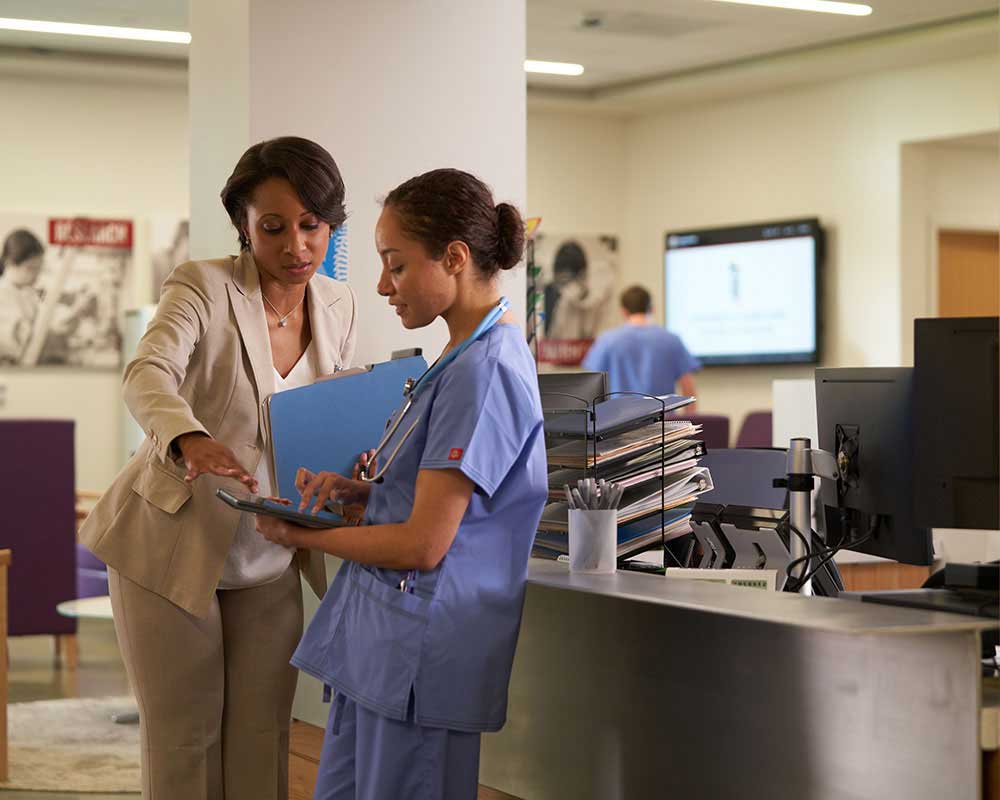The Value of Medical Administration in Health Care Management
The Value of Medical Administration in Health Care Management
Blog Article
Ideal Practices in Medical Administration for Improving Performance and Decreasing Costs
In the ever-evolving landscape of healthcare, the search of ideal methods in clinical administration is critical for boosting performance and suppressing costs. By integrating innovative innovations such as digital wellness documents and telemedicine, healthcare companies can improve operations and boost client treatment. Innovation alone is not a remedy; enhancing source allocation and promoting joint communication amongst treatment groups are just as vital. As organizations strive to balance top quality and cost, what methods should be focused on to achieve these twin goals? The responses to these concerns hold the trick to a much more sustainable medical care system.
Leveraging Advanced Technology
In today's rapidly progressing medical care landscape, leveraging innovative technology is no longer optional yet crucial for effective clinical management. The integration of electronic options right into healthcare systems has actually transformed the method facilities run, improving processes and improving client treatment. Electronic Health Records (EHRs) are essential, offering detailed person data that can be accessed immediately by authorized personnel, thus minimizing redundancy and lessening errors. By streamlining individual details, EHRs get rid of the need for cumbersome paperwork and promote smooth communication amongst health care suppliers.
Telemedicine is another technical advancement that has actually changed person interaction. It supplies comfort for both clients and medical care professionals by enabling remote examinations, which can decrease the need for in-person check outs and maximize consultation organizing. Additionally, telehealth systems can expand healthcare access to country or underserved areas, linking spaces in treatment delivery.
Additionally, making use of Expert system (AI) and artificial intelligence is ending up being significantly common in predictive analytics, permitting early detection of prospective health and wellness issues and more informed decision-making. These innovations, when integrated successfully, can boost diagnostic accuracy and personalize individual therapy strategies, ultimately bring about improved healthcare outcomes and functional effectiveness.
Optimizing Resource Allotment
Reliable source allocation is crucial for optimizing the performance of medical management. By tactically managing sources such as personnel, tools, and funds, medical care centers can dramatically enhance their operational performance, improve patient end results, and minimize unneeded expenditures. The initial step in optimizing source allotment involves conducting a comprehensive analysis of existing possessions and determining locations where resources might be underutilized or exhausted. This evaluation must be data-driven, using metrics and analytics to educate decision-making procedures.
Focusing on resource allocation based upon client demands and service needs is vital. This involves straightening resources with high-demand areas, such as emergency care or specialized therapies, to guarantee timely and efficient individual care. Applying flexible staffing models can likewise enhance labor sources by changing employees allocation in action to fluctuating person quantities. In addition, accepting telemedicine and various other technological options can reduce physical source restraints by providing different opportunities for patient-provider interactions.
Financial resources must be thoroughly kept an eye on and designated with strategic foresight to sustain both temporary operational demands and long-lasting institutional goals. This includes investing in training programs that enhance staff competencies and adopting energy-efficient practices that minimize operational expenses (medical administration). Eventually, an optimized source allowance strategy promotes a sustainable healthcare setting that is responsive, effective, and financially sensible
Streamlining Process Procedures
When healthcare centers goal to enhance operational performance, streamlining workflow procedures ends up being a crucial emphasis. Reliable operations lessen redundancy, eliminate unneeded actions, and enhance control among healthcare professionals. This strategy not just increases solution shipment yet additionally enhances the high quality of person care.

Next, innovation combination plays a substantial duty in enhancing operations. Carrying out digital health records (EHRs) and digital physician order entrance (CPOE) systems lowers documents, lessens human error, and guarantees info is obtainable to all relevant employees. Furthermore, leveraging telemedicine platforms can streamline client consultations and follow-ups, lowering the strain on physical facilities.

Ultimately, streamlined operations result in cost decreases and boosted individual contentment, promoting an extra sustainable medical care setting.
Enhancing Data Management
Structure upon streamlined workflows, maximizing information management ends up being a crucial component in progressing healthcare management. Effective information monitoring systems are essential for maintaining accurate patient documents, enhancing decision-making, and making sure compliance with regulative requirements. By carrying out robust information administration services, healthcare facilities can improve the high quality of client treatment while concurrently minimizing functional expenses.
One key element of improving information monitoring is the integration of advanced electronic wellness document (EHR) systems. These systems facilitate the seamless exchange of client info across various departments, lowering duplication of examinations and decreasing errors. read the full info here A well-designed EHR system sustains data analytics, making it possible for doctor to recognize patterns and make notified choices relating to person care.
Furthermore, securing client information is paramount. Taking on thorough cybersecurity procedures, including encryption and regular audits, guarantees the honesty and confidentiality of sensitive information. This not just protects patients yet likewise maintains the organization's online reputation.
Buying staff training is another critical variable. Enlightening healthcare experts on information monitoring methods enhances their capacity to effectively use technology, leading to improved person results. In verdict, improving information monitoring through innovative modern technology and comprehensive training is vital for attaining effectiveness and price reduction in medical administration.
Fostering Collaborative Communication
An essential part ahead of time clinical management is cultivating collaborative communication among health care specialists. Reliable communication is critical for ensuring smooth client treatment, enhancing therapy end results, and lessening errors. By urging open discussion and sychronisation throughout multidisciplinary groups, medical care companies can enhance their functional effectiveness and decrease unneeded costs.
Central to this approach is the assimilation of interaction technologies such as electronic health and wellness records (EHRs) and secure messaging systems, which assist in the fast exchange of important person info. These devices enable health care suppliers to access and share information in actual time, ensuring that all staff member are informed and straightened in their decision-making processes. Moreover, normal team meetings and interdisciplinary rounds can even more promote a culture of partnership and accountability.
Training programs focused on improving communication abilities are also necessary. These programs can help personnel develop the capacity to convey information plainly and listen proactively, hence lowering misconceptions and cultivating an encouraging job setting. Furthermore, adopting standard interaction methods, such as SBAR (Situation, Background, Assessment, Suggestion), can streamline the exchange of info, making sure that critical information are communicated succinctly and effectively. Ultimately, cultivating collaborative interaction causes improved healthcare shipment and cost savings (medical administration).

Final Thought
Including sophisticated technology, such as digital wellness documents and telemedicine, alongside maximized resource appropriation and streamlined process processes, is vital for improving performance this contact form in clinical management. Efficient information administration and cultivating joint interaction amongst healthcare groups are critical for decreasing redundancies and improving treatment quality. By prioritizing precautionary care and engaging in quality enhancement campaigns, healthcare companies can attain substantial cost financial look at here now savings and improved person outcomes, consequently making certain lasting healthcare shipment in a progressively intricate setting.
Report this page